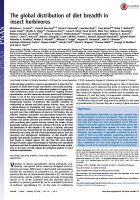Global distribution of diet breadth in insect herbivores
Forister M.L., Novotny V., Panorska A.K., Baje L., Basset Y., Butterill P.T., Cizek L., Coley P.D., Dem F., Diniz I.R., Drozd P., Fox M., Glassmire A., Hazen R., Hrcek J., Jahner J.P., Kaman O., Kozubowski T.J., Kursar T.A., Lewis O.T., Lill J., Marquis R.J., Miller S.E., Morais H.C., Murakami M., Nickel H., Parkikes N., Ricklefs R.E., Singer M.S., Smilanich A.M., Stireman J.O., Villamarín-Cortez S., Vodka S., Volf M., Wagner D.L., Walla T., Weiblen G.D., Dyer L.A. 2015. Proceedings of the National Academy of Sciences of the United States of America 112(2): 442-447. doi/10.1073/pnas.1423042112

Abstract
Understanding variation in resource specialization is important for progress on issues that include coevolution, community assembly, ecosystem processes, and the latitudinal gradient of species richness. Herbivorous insects are useful models for studying resource specialization, and the interaction between plants and herbivorous insects is one of the most common and consequential ecological associations on the planet. However, uncertainty persists regarding fundamental features of herbivore diet breadth, including its relationship to latitude and plant species richness. Here, we use a global dataset to investigate host range for over 7,500 insect herbivore species covering a wide taxonomic breadth and interact- ing with more than 2,000 species of plants in 165 families. We ask whether relatively specialized and generalized herbivores represent a dichotomy rather than a continuum from few to many host families and species attacked and whether diet breadth changes with increasing plant species richness toward the tropics. Across geographic regions and taxonomic subsets of the data, we find that the distribution of diet breadth is fit well by a discrete, truncated Pareto power law characterized by the predominance of specialized herbivores and a long, thin tail of more generalized species. Both the taxonomic and phylogenetic distributions of diet breadth shift globally with latitude, consistent with a higher frequency of specialized insects in tropical regions. We also find that more diverse lineages of plants support assemblages of relatively more specialized herbivores and that the global distribution of plant diversity contributes to but does not fully explain the latitudinal gradient in insect herbivore specialization.
Download
Global distribution of diet breadth in insect herbivores


